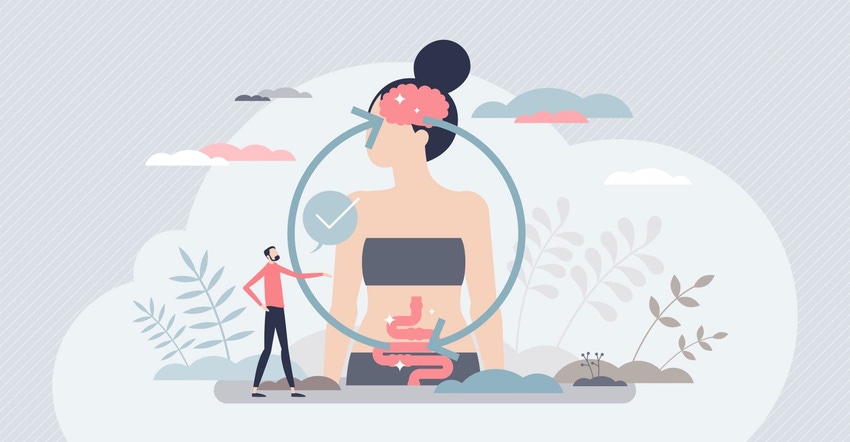Influencing the microbiota-gut-brain axis
The microbiota-gut-brain-axis is complex, but developing efficacious brain health supplements doesn’t have to be.

When a person faces a stressor, the body’s stress response systems—including the hypothalamic-pituitary-adrenal (HPA) axis and the autonomic nervous system—start functioning to not only prepare the body for stress, but also to get back to a baseline of homeostasis once the stressor is gone.
Unfortunately, when an individual experiences too much stress or when stress starts to become chronic, these systems can malfunction, leading to an increased risk of developing mood disorders such as depression and anxiety.
Stress impacts the physiology of the entire body, even affecting the composition and function of the microbes within the gut.1 In fact, the microbes within the gut can also influence one’s response to stress. The inner workings of this complex stress response are only recently coming to light.
Scientific evidence linking the gut and brain continues to mount. As understanding increases about how the gut—and the microbes that reside there—can influence stress, interest in probiotics that target brain health via the gut seems to grow at a commensurate rate.
Probiotics can influence the gut microbiome to elicit mental health benefits and influence the stress response via a complex bidirectional communication pathway called the microbiota-gut-brain axis.2 The HPA axis is the body’s central stress response system, and it is one pathway of bidirectional communication between the gut and the brain.
This bidirectional pathway of communication is essential for maintaining homeostasis of the gastrointestinal (GI), central nervous and microbial systems in the body.3 If a scientist were asked to picture a map of this endlessly complex system in their mind’s eye, chances are that they’d think of the autonomic nervous system, which comprises the enteric nervous system and the vagus nerve, the neuroendocrine system, the HPA axis, the immune system and various other metabolic pathways.
Charting a course through the microbiota-gut-brain axis
Microbes within the gut can produce neurotransmitters such as gamma-aminobutyric acid (GABA), noradrenaline, dopamine and serotonin, as well as neuroactive amino acids such as tryptophan. These neurotransmitters and neuroactive compounds can influence gut-brain signaling via the microbiota-gut-brain axis and ultimately influence behavior, including how someone responds to stress. Other microbes in the gut can produce short-chain fatty acids (SCFAs) that have been associated with regulating neuronal function and reducing depressive-like behavior in mice.4
Within the nervous system, stress can activate the HPA axis response, triggering a cascade of hormone production that starts within the brain, and ultimately resulting in the synthesis and release of cortisol. Cortisol can regulate neuroimmune signaling responses that affect intestinal permeability. Stress hormones can also activate neuronal cells of the enteric nervous system (the network of nerves at the interface between the microbiota and the host along the GI tract), which can change the gut environment and even alter the gut microbiota composition.
Within the gut, host-microbe interactions influence the release of several neurological and immunological signaling molecules, including neurotransmitters and amino acids such as those mentioned above, microbial byproducts and metabolites. These influence the neuroendocrine and immune system, which in turn influence metabolic pathways by signaling through the enteric nervous system and vagus nerve to influence brain function and even behavior.
The stress factor
In the past, germ-free mouse models have been used to show that mice lacking in gut microbes experience an altered stress response, with some studies showing that germ-free mice experience a heightened stress response and an exaggerated production of stress hormones in response to an experimental stressor, compared with conventionally colonized mice. Interestingly, the stress response in these mice could be normalized once these germ-free mice became colonized with healthy bacteria such as Bifidobacterium infantis.5
When it comes to stressed-out humans, solid evidence suggests a link between probiotics’ effect on brain health and the underlying stress an individual may experience.6 For example, researchers recently discovered that adults who were subjected to significant stressors showed an increase in working memory after probiotics supplementation—a similar group that did not face any stressors saw little-to-no improvement. Results showed that neurocognitive effects of a multispecies probiotic in healthy women manifested only under challenging situations, buffering against the detrimental effects of stress on cognition. The physiological and psychological benefits of probiotics on stress and mood outcomes have been investigated in several preclinical trials using different models, with some translation to clinical trials in different populations, ranging from healthy participants to subjects under various stress levels.2
Choosing a stress-specific strain
Brands across the nutritional supplement industry have pored over the clinical research comprehensively summarized in the 2019 review by Cryan et al., aiming to find new microbial ingredients that consistently ease stress. In 2015, that search led the HOWARU team to launch a complex preclinical study to investigate 12 candidate probiotic strains to determine whether any of them could attenuate stress-related behaviors from developing in anxious mice.7
At the end of the study, three promising candidate probiotics emerged. Chief among them was HOWARU Lpc-37 L. paracasei (Lpc-37), a strain previously isolated from a dairy source. Lpc-37 was already a well-documented strain from our portfolio at the time, included in over 20 clinical studies to date.
The results in mice during these trials were impressive, with Lpc-37 preventing anxiety- and depressive-like behavior from developing in mice presenting with an anxious phenotype because of exposure to chronic stress for three weeks during the five-week single-strain interventions. With efficacy shown in preclinical trials, we started investigating Lpc-37 for efficacy in a human clinical trial.
Making the human connection
The HOWARU team began a randomized, double-blind, placebo-controlled clinical trial to assess the efficacy of Lpc-37 on stress and anxiety over a seven-week period—this included a five-week intervention with either Lpc-37 at a dose of 17 billion colony-forming units (CFUs) per day or placebo, depending on the group to which the participants were randomly allocated.
In total, 120 healthy men and women—ages 18 to 45—were enrolled in the Sisu study, conducted at a single site in Trier, Germany.8 For their first visit with researchers, participants underwent screening, followed by a two-week run-in period when participants were not permitted to consume any products containing concentrated sources of pre- or probiotics or antibiotics; during their second visit, researchers established each participant’s baseline, after which the participants consumed either Lpc-37 or placebo daily for five weeks.
Upon their third visit with researchers, after having taken either Lpc-37 or placebo for five weeks, participants underwent a Trier Social Stress Test (TSST), considered the most valid and reliable laboratory stress protocol for humans for nearly 30 years.9
Lpc-37 had a notable impact, culminating in a significant decrease in perceived stress in the Lpc-37 group compared to the placebo group from baseline to end of study (p=0.048). Over the course of the study, women who consumed Lpc-37 for five weeks also experienced a significant reduction in perceived stress, compared to the placebo group (p=0.049). Interestingly, covariate analyses revealed that the women in the Sisu study had higher stress, sleep disruptions and felt less rested after a night’s sleep compared to the men enrolled in the study, indicating not only that sex may be an underlying factor influencing the stress response, but also that the female participants in this study could be considered more stressed than males. In addition, women in the Lpc-37 group had a significantly lower increase in systolic blood pressure in response to the acute stress test (TSST), compared to the placebo group (p=0.031).
People who entered the Sisu study with already high levels of stress saw especially significant benefits of consuming Lpc-37 as well. Judging by a series of online daily diary entries taken throughout the study—including the two-week run-in and the five-week intervention—these high-stress participants experienced a significant improvement in their sleep recovery (how rested they felt after a night of sleep) compared to the placebo group (p=0.006). They also enjoyed an improved perception of their own health (p=0.012) and increased productivity (p=0.037), compared to the placebo group, as assessed using the online daily diary throughout the study. For manufacturers hoping to create products for the highly stressed, these results show great promise.
Calm is a state of mind
The microbiota-gut-brain-axis is complex, but developing efficacious brain health supplements doesn’t have to be. When formulating a probiotic supplement for brain health, formulators and manufacturers should choose strains that have been clinically studied for safety and efficacy. They should also ensure the strains have been formulated and evaluated to ensure availability through end of shelf life, as well as tested for toxicity to confirm safety for human consumption.
By pairing strains like Lpc-37 with other natural relaxants, manufacturers can maximize end-product benefits while standing out on the shelves. Psychobiotics like HOWARU Calm can be paired with botanicals like passionflower (Passiflora incarnata), valerian (Valeriana officinalis) or lemon balm (Melissa officinalis) to help consumers manage the feelings of stress. This allows manufacturers to develop new probiotic blends that help differentiate them in a crowded marketplace, while helping consumers cultivate a sense of calm.
The human body is equipped with exceptional tools to deal with the challenges of life, including the microbiota-gut-brain axis that so thoroughly dictates a person’s emotional state from moment to moment. Brands that offer products to help keep the gut flora in check can aid consumers in making sure their “gut feelings” truly contribute to peace of mind.
To dive deeper into articles on brain health, check out the “Focus on cognitive health” digital magazine.
Elaine Patterson, Ph.D., is senior scientist and technical lead of the gut-brain health platform at IFF Health. Long curious about the links between diet, the gut microbiome and health, she has degrees in neuroscience and microbiology. During post-doctoral research at APC Microbiome Ireland, Patterson dived deep into the microbiome-gut-brain axis. Today, she continues to explore how dietary supplements, including probiotics, can impact brain physiology, function and behavior to influence human health.
References
1 Bailey MT et al. “Exposure to a social stressor alters the structure of the intestinal microbiota: Implications for stressor-induced immunomodulation.” Brain Behav Immun. 2011;25(3):396-407.
2 Cryan JF et al. “The Microbiota-Gut-Brain Axis.” Physiol Rev. 2019;99(4):1877-2013.
3 Morais LH et al. “The gut microbiota-brain axis in behaviour and brain disorders.” Nat Rev Microbiol. 2021;19(4):241-255.
4 Schroeder FA et al. “Antidepressant-like effects of the histone deacetylase inhibitor, sodium butyrate, in the mouse.” Biol Psychiatry. 2007;62(1):55-64.
5 Sudo N et al. “Postnatal microbial colonization programs the hypothalamic-pituitary-adrenal system for stress response in mice.” J Physiol. 2004;558(1):263-275.
6 Papalini S et al. “Stress matters: Randomized controlled trial on the effect of probiotics on neurocognition.” Neurobiol Stress. 2018;10:100141.
7 Stenman LK et al. “Strain specific stress-modulating effects of candidate probiotics: A systematic screening in a mouse model of chronic restraint stress.” Behav Brain Res. 2020;379:112376.
8 Patterson E et al. “Lacticaseibacillus paracasei Lpc-37 improves psychological and physiological markers of stress and anxiety in healthy adults: a randomized, double-blind, placebo-controlled and parallel clinical trial” (the Sisu study).” Neurobiol Stress. 2020;13:100277.
9 Allen AP et al. “The Trier Social Stress Test: Principles and practice.” Neurobiol Stress. 2016;6:113-126.
About the Author(s)
You May Also Like






.png?width=800&auto=webp&quality=80&disable=upscale)